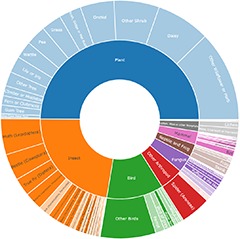Polypores - Non-fleshy texture, stems central or lateral
Some species in this sub-group produce fruitbodies with caps that are thin and leathery, but pliable, whereas other species produce fruitbodies with thick, corky and unpliable caps.
In the following hints you see examples of useful identification features and a few of the more commonly seen genera in which at least some species (not necessarily all) show those features.
Hints
On wood; pores radially elongated: Polyporus.
On wood; whitish cap to a centimetre or so in diameter: Panellus.
On soil; thin, brown, concentrically banded cap: Coltricia.
On soil; thick cap, brown on upper side & with white pores that bruise red: Amauroderma.
Warning
If you think you have a small-pored member of this sub-group, it pays to check with a magnifying glass or hand lens. Some species of the Caps on stems; teeth below caps group produce leathery fruitbodies in which the teeth are so densely packed that, at first glance, you might think the underside has small pores.
Announcements
Hi All,We need to deploy a major platform update shortly at 4pm - so there will be a temporary outage of approximately 60 mins.We apologise in advance for this inconvenience and thank you for your pat...
Continue reading
Platform update continued 30 JAN 2025
Major upgrade under way. Some known issues.
Discussion
Lentinus arcularius
Lentinus arcularius
Sanguinoderma rude
Lentinus arcularius
Significant sightings
Recent activity
Ganoderma sp. (laccate, stemmed) at Pillar Valley, NSW
Lentinus arcularius at Borough, NSW
Top contributors
- trevorpreston 22
- Teresa 21
- ArcherCallaway 12
- JackyF 9
- Paul4K 9
- Csteele4 8
- drakes 6
- LisaH 6
- KenT 5
- mahargiani 4
Top moderators
- Heino1 100
- Teresa 29
- Heino 23
- Pam 18
- KenT 16
- Csteele4 11
- JTran 7
- CanberraFungiGroup 3
- MichaelMulvaney 3
- KerryVance 2








